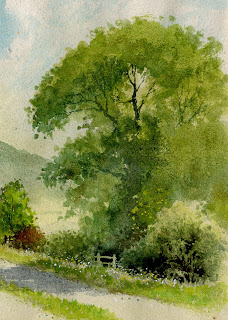Autumn is upon us, and with the trees turning colour it’s a great time to be out capturing those magical views, whether in sunshine, rain or whatever: rain can create more atmospheric scenes, but if you can catch that moment after a shower when the sun comes out and makes everything sparkle it can be truly magical – watch out for those stunning reflections of colour and light in the puddles.
This year autumn is also bringing out my new book, Landscapes Through the Seasons, which has just been published by Search Press. It is in fact an expansion and update of my Winter Landscapes book – many people were asking about a summer book, but with other books in the pipeline I could not have written a whole book on summer landscapes for several years. The spring and autumn sections have also been expanded.
The illustration shows a watercolour sketch done on a cartridge sketchbook on a sunny November afternoon and reproduced in the book. If you are out sketching at this time of the year it really does pay to use colour, whether in watercolour, watercolour pencils, acrylics, inks or whatever you fancy. Note that the most powerful effects occur when abutting the complementary colours of purple and orange against each other – if that tree of glowing orange doesn’t quite come in front of that distant purple hill, then give it an artistic shove and see the effect. Likewise warm yellows against the blues and purples will make your autumn scenes sing. Flying leaves and trees with just a few single leaves remaining can add to the season’s visual treasures, and these can be achieved in watercolour by little dabs of masking fluid. By applying a dark colour over these dabs you can then create sparkling light leaves when you rub off the masking fluid. Let your yellows, reds and oranges run into one another in the foliage to vary the overall effect.
The later paintings in the book are carried out with Daniel Smith Extra-fine watercolours, and many of these are exceptionally effective for autumn colours, such as Aussie red gold, transparent red oxide, moonglow and quinacridone Sienna. Quinacridone gold and gamboge are also great colours for this time of year. We all need something new to brighten up these difficult days of lockdowns, so treat yourself to some of these amazing colours.






